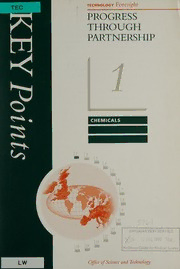
Chemicals PDF
Preview Chemicals
. PARTNERSHIP w, 5 4 1 = CHEMICALS THE SEG TOR There is a strong interaction between the industry and its scientific/academic base which has led to a steady flow of innovative products and processes to meet the existing and future needs of society. The chemical industry underpins the majority of other sectors of the economy, sales account for 2.2% of GDP and contribute a surplus of around £4 billions annually to the balance of trade. There are 3,600 business units in the chemicals sector, employing nearly 300,000 people (with indirect employment accounting for almost as many again). THER BORE The future of the sector will be based on growth from the established community strengths, with research and innovation providing cleaner and more efficient processes, and higher added-value products. Increasing interdisciplinarity, combined with high quality basic and applied research will benefit existing industry and generate new avenues of opportunity, increasingly on a global scale. RECOMMENDATIONS The key recommendations comprise 5 technical and 4 infrastructural areas. The technical areas are: ¢ A New Institute for Applied Catalysis - multidisciplinary and industrially focused ¢ Chemical Engineering - increase multidisciplinarity and discipline support ¢ Sensors & Measurement - support work on robust sensors for control of processes ¢ Materials/Polymers - synthesis, processing and property/structure relationship ¢ Biochemical Technology - foster interaction of chemistry/biology. The infrastructural areas are: * Maintenance of excellence in leading edge disciplines - maintain the depth and the breadth of basic research in addition to key recommendations * Education and Training - provision of technically competent trained manpower at all levels ¢ Image of chemical industry - coordination of existing initiatives and focus on schools ° Networking - focus on technology diffusion and SME involvement. TECHNOLOGY Foresight 22501158742 1 = CHEMICALS FORWARD WITH FORESIGHT The dissemination of the Foresight exercise is important not only in terms of its output but also in terms of promotion of the process itself at subsector, institution or company level. Dissemination of results The Chemical Industries Association will disseminate the results into industry via personal contacts and general workshops. Department of Trade and Industry has a key role in communicating regionally and specifically to SMEs. Particularly important here is the role of technology diffusion, for example via LINK and the Teaching Company Scheme. Utilising Chambers of Commerce, trade organisations and supply chain links from major companies to promote awareness of Foresight. Promotion of increased collaboration at a general level The Research councils should ensure that interdisciplinary and multidisciplinary research is supported in their funding. The criteria for the Research Assessment Exercise should be adjusted to reflect the importance of both multidisciplinary work and of industrial collaboration. There should be increased joint funding of projects by more than one Research Council, particularly EPSRC/BBSRC in biotechnology. Funding bodies and universities should support the creation of joint departmental appointments and joint academic/industrial appointments. Promotion of interdisciplinarity in specific cases Formation of the Institute of Applied Catalysis must be overseen by a joint industry/ academe project management team with a specific remit to involve the range of disciplines required to generate industrially applicable benefits. There must be free movement to/from this Institute into academe (a hub/spokes model) in order to spread this interdisciplinary approach. A selected number of chemical engineering departments should be encouraged to adopt a more multidisciplinary approach to staffing covering, for example, colloid science, physical chemistry, surface science, control engineering and mathematical modelling. TECHNOLOGY Foresight 1 == CHEMICALS TECHNOLOGY FORESIGHT PROGRAMME The purpose of the Technology Foresight Programme is to help business people, engineers and scientists become better informed about each other’s efforts. It is bringing these communities together in networks - looking forward in partnership - which will help to identify emerging opportunities in markets and technologies. The Programme will also help to ensure that resources are used to best effect in support of wealth creation and improving the quality of life. The results of Foresight will inform decisions on spending by Government and industry. Foresight findings are available to small and medium sized enterprises which may not have the resources to undertake Foresight work on their own account. The Technology Foresight Programme is co-ordinated by the Office of Science and Technology (part of the Cabinet Office). Foresight panels have been working in each of the following 15 sectors: Agriculture, Natural Resources Health & Life Sciences & Environment IT/Electronics Chemicals Leisure & Learning Communications Manufacturing, Production Construction & Business Processes Defence & Aerospace Materials Energy Retail & Distribution Financial Services Transport Food & Drink Summary leaflets (like this one) are available for each sector. Copies of these documents are available from the Office of Science and Technology, Albany House, 84-86 Petty France, London, SW1H 9ST (Fax: 0171-271-2015). Full reports for each sector are available from Her Majesty’s Stationery Office. TECHNOLOGY Foresight
